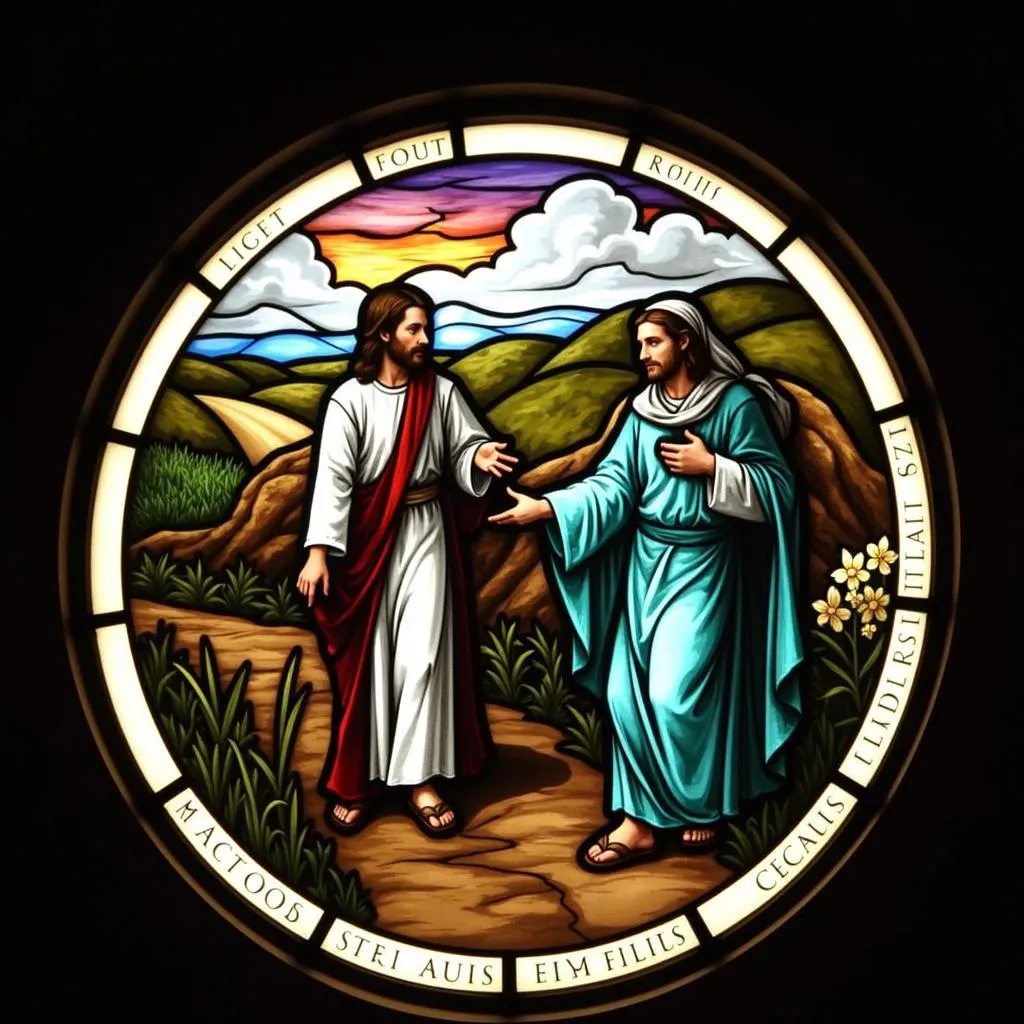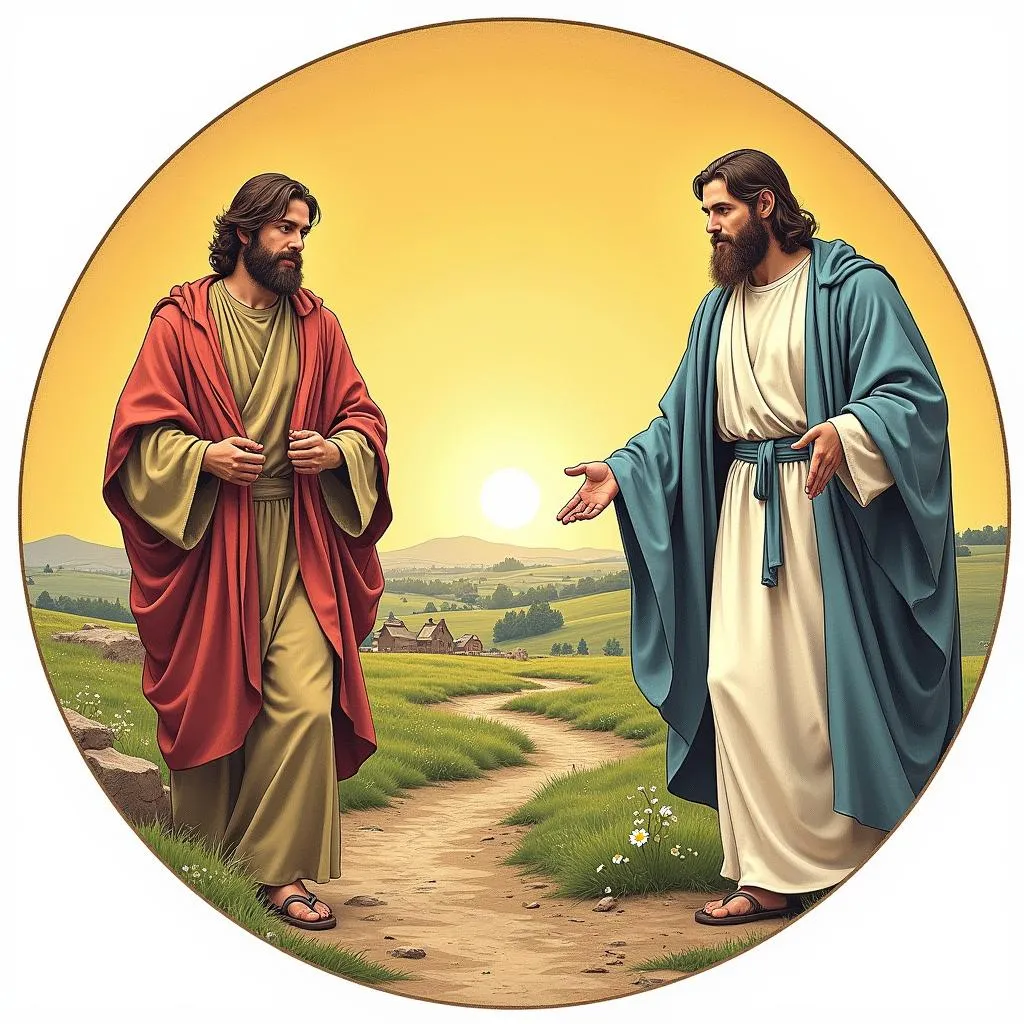The Emmaus Symbol, often depicted as two figures walking together, holds a profound meaning for the Christian community. It serves as a reminder of the transformative power of faith, the importance of community, and the unwavering hope found in the resurrection of Jesus Christ. This article delves into the historical origins, symbolism, and enduring legacy of the Emmaus symbol, offering a deeper understanding of its significance for believers and non-believers alike.
The Story of Emmaus: A Tale of Encounter and Transformation
The Emmaus symbol derives its inspiration from a pivotal event in the Gospel of Luke, where two disciples are walking along the road to Emmaus, disheartened by the recent crucifixion of Jesus. As they converse, a stranger joins them, engaging in a lively discussion about the Scriptures. Unbeknownst to the disciples, this stranger is none other than the risen Christ.
As they near Emmaus, the stranger prepares to leave, but the disciples urge him to stay. “Stay with us, for it is nearly evening and the day is almost over,” they plead. To their astonishment, the stranger accepts their invitation and joins them for dinner.
During the meal, the stranger breaks bread, and in that moment, the disciples recognize him as Jesus. Filled with joy and astonishment, they immediately return to Jerusalem to share the good news with the other disciples. This encounter on the road to Emmaus is a powerful illustration of the transformative power of faith and the unexpected ways in which Jesus reveals himself to his followers.
The Symbolism of the Emmaus Symbol
The Emmaus symbol typically depicts two figures walking together, often accompanied by a third figure representing Jesus. The symbolism is multifaceted and can be interpreted in various ways:
1. The Journey of Faith: The two figures represent the disciples on their journey of faith. They are initially filled with doubt and despair, but through their encounter with Jesus, their faith is restored and they are transformed.
2. The Importance of Community: The act of walking together signifies the importance of community and fellowship in the Christian faith. The disciples find solace and support in each other’s company, especially during a time of great sorrow and uncertainty.
3. The Presence of Christ: The third figure, representing Jesus, symbolizes his presence and guidance in the lives of believers. Even when they feel lost or alone, Jesus is always with them, offering comfort, hope, and direction.
4. The Breaking of Bread: The act of breaking bread together is a powerful symbol of the Eucharist, a central sacrament in Christianity. It represents the sharing of Christ’s body and blood, and the renewal of faith and fellowship among believers.
The Enduring Legacy of the Emmaus Symbol
The Emmaus symbol has resonated with Christians throughout the centuries, serving as a source of inspiration and comfort. It reminds believers that even in the darkest of times, hope and renewal are always possible.
“The Emmaus symbol is a powerful reminder that God’s grace and love can transform even the most disheartening of situations.” – Rev. Dr. Mary Thompson, Theologian and Author
The symbol is also widely used in church architecture, art, and literature. From stained glass windows to sculptures to devotional writings, the Emmaus symbol serves as a tangible reminder of the transformative power of faith and the enduring presence of Christ in the lives of believers.
FAQs:
1. What does the Emmaus symbol represent in Christianity?
The Emmaus symbol represents the transformative power of faith, the importance of community, and the unwavering hope found in the resurrection of Jesus Christ.
2. Where does the Emmaus symbol come from?
The symbol derives its inspiration from a pivotal event in the Gospel of Luke, where two disciples encounter the risen Jesus on the road to Emmaus.
3. What is the significance of the two figures in the Emmaus symbol?
The two figures represent the disciples on their journey of faith, symbolizing the importance of fellowship and the transformative power of encountering Christ.
4. What is the significance of the third figure in the Emmaus symbol?
The third figure represents Jesus, symbolizing his presence and guidance in the lives of believers.
5. How is the Emmaus symbol used in contemporary Christianity?
The Emmaus symbol is widely used in church architecture, art, and literature, serving as a tangible reminder of the transformative power of faith and the enduring presence of Christ.
6. What is the historical context of the Emmaus symbol?
The Emmaus symbol originated from the biblical narrative of the disciples’ encounter with the risen Jesus on the road to Emmaus, as described in the Gospel of Luke.
7. How does the Emmaus symbol inspire people today?
The Emmaus symbol continues to inspire people today by reminding them that hope and renewal are always possible, even in the face of adversity. It encourages faith, community, and the pursuit of a deeper relationship with Christ.
 Emmaus Symbol Artwork
Emmaus Symbol Artwork
 Emmaus Symbol in a Church
Emmaus Symbol in a Church
 Emmaus Symbol: Journey of Faith
Emmaus Symbol: Journey of Faith
The Emmaus symbol remains a powerful reminder of the transformative power of faith, the importance of community, and the enduring presence of Christ. It serves as a source of inspiration and hope for believers across the globe, reminding them that even in the darkest of times, there is always a path to renewal and spiritual growth.